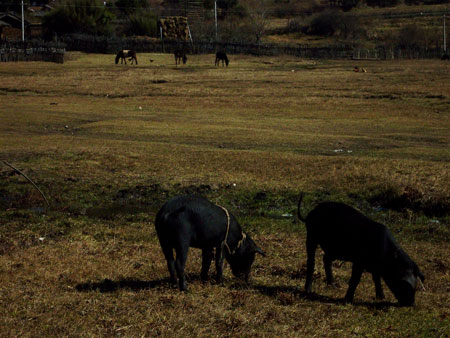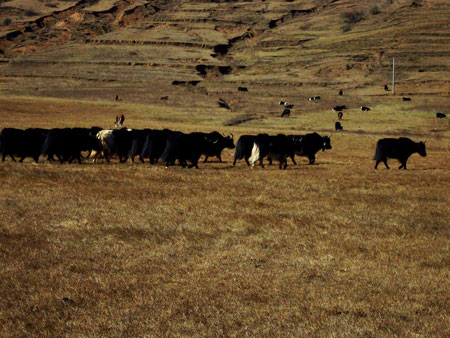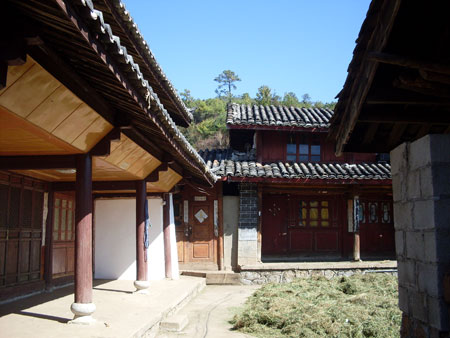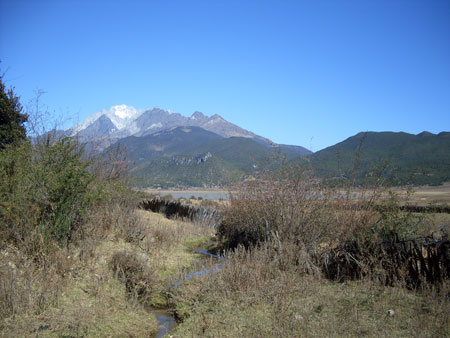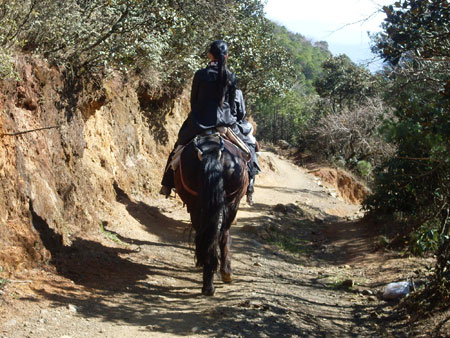Hiking in Lijiang-1
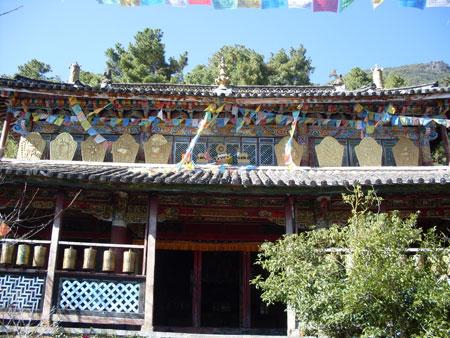
- Yufeng Lamasery
Route: From Yufengsi to Wenhai Lake
Hikers:Thomas Lu,Bruce Lee (our travel guide who has the same family name with his idol-Bruce Lee,he adores him almost crazy and collects every things about this super Kungfu star),Ripple Sage Tan (me)
Duration:3.5hrs
Attractions: Dragon snow mountain,trees (trees,trees,always trees),flowers,sheep,yaks,a reservoir,horses,donkeys,mules,pigs,squirrels,birds,wild boar(we met one,fortunatelly,the creature didn’attack us),frozen earth,snow,riders,indigenes (Naxi people)…
About Wenhai Lake
Wenhai Lake is located at the western foot of Shanzidou,the main peak of Drgon Snow Mountain.The lake covers an area of 676 hectares and is at an elevation of 3180 metres.It is a superb destination for those who enjoy hiking,botanizing,canoeing,horse riding and fishing.Some of the many species in the lake include Lijiang hemlock spruce,firs,yews,Psammosilene tunicoides,Skapanthus oreophilus,Sorolepidium glaciale Christ,Rhododendron alutaceum Balf,Gastrodia elata Bl,worm grass,Fritillaria thunbergii,vermiculate thamnolia thallus,Radix Gentianae,Camellia japonica Linn (Common Camellia),Primula malacoides,Magnolia liliflora,lily and orchid savona,and so forth.
My Sanjiang Tour

A Wind and Rain Bridge in Chengyang Scenic Area
Sanjiang, literally “the three rivers” in English, the Rong River, Xun River and Miao River meet and twist through the county, hence the name. Located in the north Guangxi, China, the region is traditionally inhabited by the Dong people and about 4hrs drive from Guilin.
On July6, I visit the Chengyang Wind and Rain Bridge Scenic Area of Sanjjiang. The area is only 19 km from the seat of Sanjiang County and consists of 8 connected Dong villages. They are Ma An, Ping Tan, Ping Zhai, Yan Zhai, Dong Zhai, Ping Pu, Ji Chang and Da Zhai. I bought a ticket and enter from Da Zhai (aka Chengyang Village). The ticket entitled me to watch a show (at 10:30am) and drink a cup of traditional oil tea. The show was performed by the local girls. The girls were all from the nearby villages and all wore their traditional Costumes. They looked something simple but very beautiful. The show is quite lively,the performers danced to very beautiful music. Their musical instruments, such as Lusheng, Dong-style Pipa and Suona etc. look something different from those that I have seen in other ethnic areas. The oil tea that they served me I like very much, something like the Gongcheng oil tea that I usually drink in Guilin. The locals told me the oil tea is a traditional staple of them. And they drink it every day. It is made by frying tea leaves in oil. After the leaves are fried, water is added along with peanuts, chopped onions and puffed rice. The tea is very bitter for people not used to it and salt is offered to help kill the bitterness.
Da Zhai is the biggest and most famous village among the eight villages in the scenic area. It needs five minutes in every direction from there to other villages. The village is a good place to base travels from because it has the best hotels (they are actually the local villagers’ homes) in the area, and is in the center of a large number of villages. No matter which direction you take out of Da Zhai, will take you to another village. What makes these villages so unique is that there is little evidence that it is the 21st century. Most of the local people still wear their traditional minority clothing, and the local government has made rules forbidding any modern style buildings to be built in the area, so all of the buildings are made of wood, and do not use nails, or fasteners of any kind. All the buildings are legged and built of a mortise and tendon design, and uses their own weight to hold them together. The locals call them – Diaojiaolou. The domestic animals live in the first floor, and the upper floors are the living quarters. The houses are usually three levels high. In the old days, this kind of houses was very good to keep away from the beasts.
In Chengyang Wind and Rain Bridge Scenic Area, each village at least features one drum tower. The Dong people’s drum towers are used as meeting houses, and places to send signals to the entire villages. The towers have a square foundation, and appear to have many stories. In Sanjiang, the drum towers are regarded as the symbol of the Dong villages. I entered the towers and found some of them have the benches, tables, even the fire pits, but commonly, they all have a big drum. The local people told me that the drum is used to send signals to the entire village. When there was an emergency, like a fire, or an attack, the drum would be beat, and because of the design of the structure, the sound would be amplified and could be heard for miles around.
For me, the highlight of this area is the ancient bridges. They are known as the wind and rain bridge. The one in Dazhai is my favorite. The bridge is listed as one of the three famous ancient bridges in China. Built in 1912, the semi-permanent bridge has stone piers and wooden girders and pavilions connected by a tile-roofed corridor. It is an amazing piece of architecture built without use of any fasteners of any kind. It looks very beautiful.
In the late afternoon, I visited a local family and happened to meet the whole household having their dinner. They invited me to join them. The family was very hospitable and served me their home-made strange meats, such as sour fish (uncooked), sour duck (uncooked), pickled pork etc., but my gorge rose when I put them into my mouth. The daughter of the family is very beautiful and graceful but fattish. She filled my bowl with brewed rice wine again and again, I drank a lot and became fuddled and could not count how many bowls of wine that I had drunk. At that time, I blushed at her every-now-and-then looks but not the punch of the wine. Her parents and grandparents seemed to be very interested in my family, my age and even my marital status. I answered each question of them. When I left the family and paid them, they didn’t accept my money and just hoped me can visit their family at any time from Guilin.
